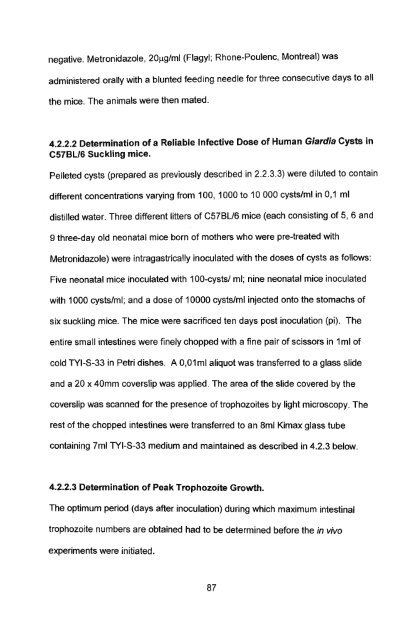in vitro culture and isoenzyme analysis of giardia lamblia
in vitro culture and isoenzyme analysis of giardia lamblia
in vitro culture and isoenzyme analysis of giardia lamblia
Create successful ePaper yourself
Turn your PDF publications into a flip-book with our unique Google optimized e-Paper software.
negative. Metronidazole, 20~g/ml (Flagyl; Rhone-Poulenc, Montreal) was<br />
adm<strong>in</strong>istered orally with a blunted feed<strong>in</strong>g needle for three consecutive days to all<br />
the mice. The animals were then mated.<br />
4.2.2.2 Determ<strong>in</strong>ation <strong>of</strong> a Reliable Infective Dose <strong>of</strong> Human Giardia Cysts <strong>in</strong><br />
C57BU6 Suckl<strong>in</strong>g mice.<br />
Pelleted cysts (prepared as previously described <strong>in</strong> 2.2.3.3) were diluted to conta<strong>in</strong><br />
different concentrations vary<strong>in</strong>g from 100, 1000 to 10 000 cysts/m I <strong>in</strong> 0,1 ml<br />
distilled water. Three different litters <strong>of</strong> C57BLl6 mice (each consist<strong>in</strong>g <strong>of</strong> 5, 6 <strong>and</strong><br />
9 three-day old neonatal mice born <strong>of</strong> mothers who were pre-treated with<br />
Metronidazole) were <strong>in</strong>tragastrically <strong>in</strong>oculated with the doses <strong>of</strong> cysts as follows:<br />
Five neonatal mice <strong>in</strong>oculated with 1 OD-cysts/ ml; n<strong>in</strong>e neonatal mice <strong>in</strong>oculated<br />
with 1000 cysts/ml; <strong>and</strong> a dose <strong>of</strong> 10000 cysts/m I <strong>in</strong>jected onto the stomachs <strong>of</strong><br />
six suckl<strong>in</strong>g mice. The mice were sacrificed ten days post <strong>in</strong>oculation (pi). The<br />
entire small <strong>in</strong>test<strong>in</strong>es were f<strong>in</strong>ely chopped with a f<strong>in</strong>e pair <strong>of</strong> scissors <strong>in</strong> 1 ml <strong>of</strong><br />
cold TYI-S-33 <strong>in</strong> Petri dishes. A 0,01 ml aliquot was transferred to a glass slide<br />
<strong>and</strong> a 20 x 40mm coverslip was applied. The area <strong>of</strong> the slide covered by the<br />
coverslip was scanned for the presence <strong>of</strong> trophozoites by light microscopy. The<br />
rest <strong>of</strong> the chopped <strong>in</strong>test<strong>in</strong>es were transferred to an 8ml Kimax glass tube<br />
conta<strong>in</strong><strong>in</strong>g 7ml TYI-S-33 medium <strong>and</strong> ma<strong>in</strong>ta<strong>in</strong>ed as described <strong>in</strong> 4.2.3 below.<br />
4.2.2.3 Determ<strong>in</strong>ation <strong>of</strong> Peak Trophozoite Growth.<br />
The optimum period (days after <strong>in</strong>oculation) dur<strong>in</strong>g which maximum <strong>in</strong>test<strong>in</strong>al<br />
trophozoite numbers are obta<strong>in</strong>ed had to be determ<strong>in</strong>ed before the <strong>in</strong> vivo<br />
experiments were <strong>in</strong>itiated.<br />
87
















